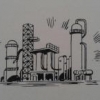Hi gegio 1960,
Thanks for sharing
Agree with your comment about unit conversion .
Now I found the resistance due to metal thermal conductivity very different from your calculation # 50 times higher !
based on external diameter , the heat transfer coefficient should be the following
1/U dirt =1/(hi*Di/Do) +1/(hdi*Di/Do) + e /(k *(Di+Do)/2 Do)+ 1 /hde +
1/he
hi : internal convection heat transfer coefficient
he : external convection heat transfer coefficient
hdi : fouling internal heat transfer coefficient
hde : fouling external heat transfer coefficient
e :pipe thickness (Do-Di)/2
Di :internal pipe diameter
Do :external pipe diameter
k : pipe thermal conductivity
please check .
Thanks
Breizh
Edited by breizh, 07 January 2021 - 12:42 AM.

 FB
FB















